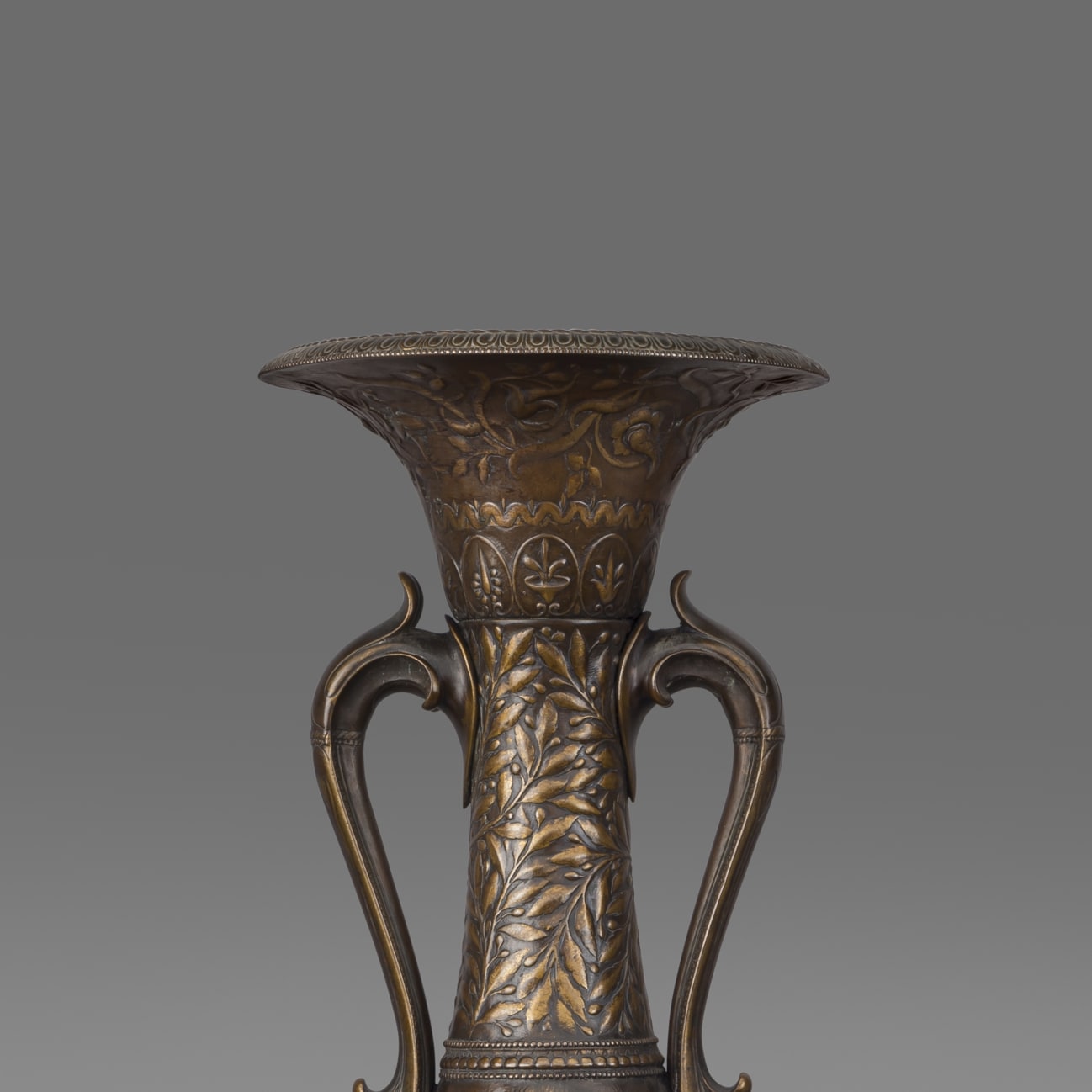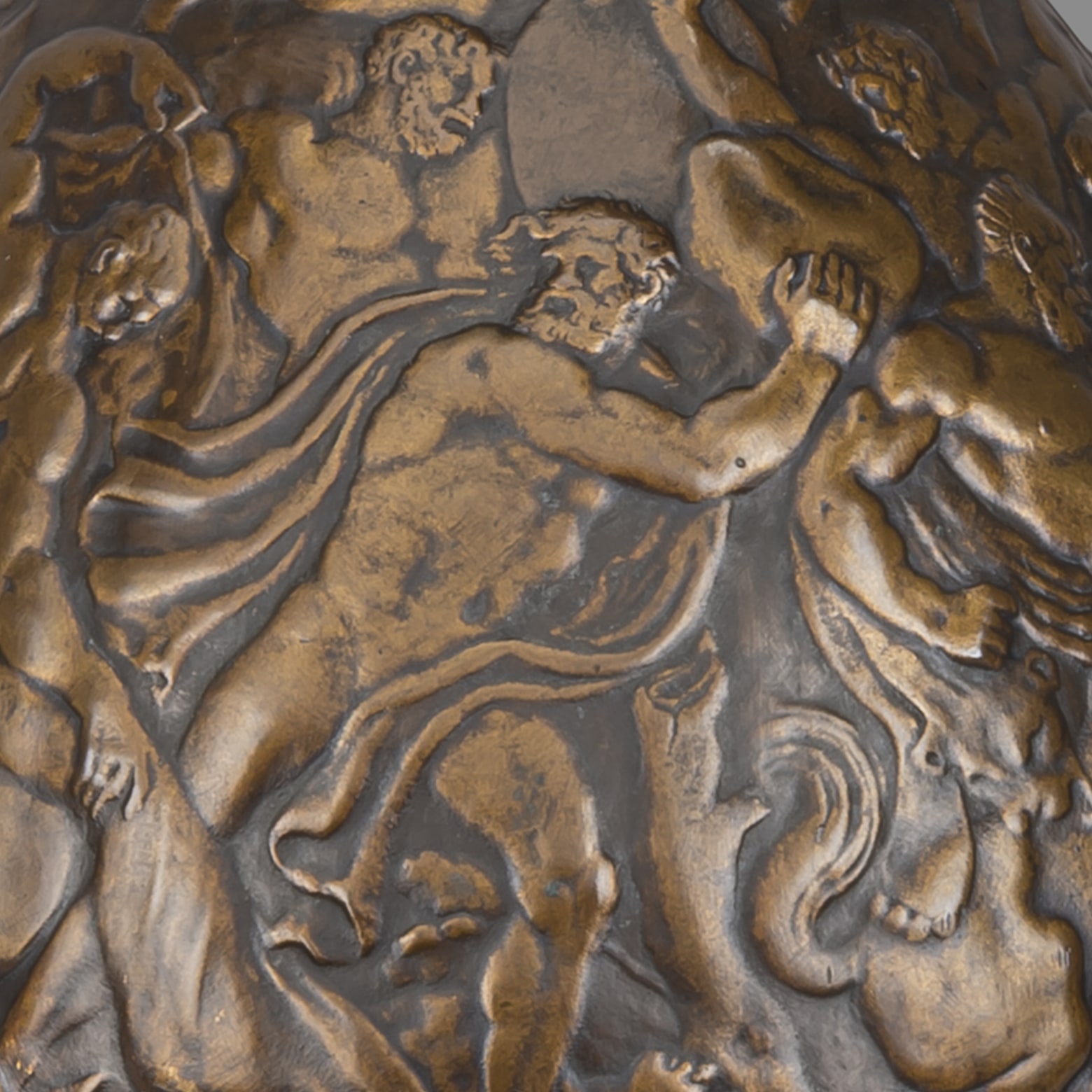Ferdinand Levillain
Un par de jarrones grandes y raros de Ferdinand Barbedienne
£14,000
A Large And Rare Pair of ‘Neo-Grec’ Style Multipatinated Bronze Amphora Vases by Ferdinand Levillain and Ferdinand Barbedienne. Signed to the cast...
Dimensiones
Height: 52 cm (21 in)Diameter: 21 cm (9 in)
Descripción
A Large And Rare Pair of ‘Neo-Grec’ Style Multipatinated Bronze Amphora Vases by Ferdinand Levillain and Ferdinand Barbedienne.
Signed to the cast ‘F. Levillain Fecit 1880’ and ‘F. Barbedienne’.
This large pair of multipatinated vases are of amphora form modelled in the ‘Neo-Grec’ style with trumpet shaped necks and scrolling handles terminating in masks; the vases are raised on circular spreading bases put down on plinths. Each vase is finely ornamented with laurel leaves and garlands to the neck, the main body with a superb banded frieze cast in low relief depicting the Centauromachy.
In the Centauromachy, the Lapiths battle with the Centaurs at the wedding feast of Pirithous. An enduring classical theme linked with the idea of culture versus nature, the Centauromachy was widely depicted in ancient Greece from the Southern Metopes of the Parthenon Freieze to the Temple of Apollo Epikourious at Bassai, it also appears as a subject on numerous Attic vases such as the Ilioupersis krater.
A popular theme for artists from the Renaissance onwards it was depicted by amongst others, Michelangelo, Piero di Cosimo, Luca Signorelli, Sebastiano Ricci, Rafael Tegeo and William-Adolphe Bouguereau and would have been a well-known subject to an educated 19th century audience.
This rare pair of vases are a fine example of the collaboration between Levillain and the highly acclaimed bronzier Ferdinand Barbedienne (d.1892).
Ferdinand Barbedienne (1810-1892)
Ferdinand Barbedienne was the inspiration and driving force behind one of the most important French art foundries. He pioneered the use of mounts and, more commonly, bronze sculpture including figures and animals. Barbedienne produced catalogues of bronze reproductions of Greek and Roman classical sculpture and experimented with champlevé and cloisonné enamels during the third quarter of the century. Barbedienne exhibited several pieces of furniture at the 1855 Paris Exhibition including an ormolu mounted oak dressing table and an ormolu mounted ebony veneered bookcase. Both pieces were executed in his favoured Renaissance revival style for furniture. Furniture with mounts signed by Barbedienne is extremely rare.
The Barbedienne foundry handled the casting of numerous national monuments and architectural schemes. Ferdinand Barbedienne himself also took an active part in the promotion of contemporary sculpture and became one of the founders for David d’Angers’ medallions as well as much of Rude’s sculpture.
His signature varied from hand written capitals to stamp in capitals, usually ‘F. Barbedienne, Fondeur’ or ‘BARBEDIENNE PARIS’.
In 1839 Barbedienne collaborated with the inventor Achille Collas who had succeeded in enlarging and reducing works of art to arbitrary sizes by a simple mathematical calculation, allowing the accurate reduction of classical and contemporary marbles for the purpose of reproduction in bronze. In 1850 Barbedienne was commissioned to furnish the Paris town hall for which he was awarded with the médaille d’honneur at the Paris Exposition Universelle in 1855.
French, Dated 1880.
Fecha
Alrededor de 1880
Origen
Francia
Medio
Bronce multipatinado
Firma
Signed to the cast ‘F. Levillain Fecit 1880’ and ‘F. Barbedienne’.
Ferdinand Levillain (1837 – 1905) had his debut at the Paris Salon in 1861 and won recognition through the 1860’s and 1870’s for his work with the highly respected Barbedienne.
In 1878 he ceased his collaboration with Barbedienne and triumphed alone at the Exposition Universelle, where he won the gold medal for his work referencing Antiquity.
In 1884 he was awarded a first class medal at the Salon and in 1889 a silver medal at the Exposition Universelle. In 1892 he was recognised with the highly prestigious Légion d’Honneur. Examples of his work are displayed in many museums including the Musée de Lyon and the Musée d’Art Moderne in Paris.
Levillain also collaborated with the Sèvres manufactory and won several medals, which are still visible today at the Louvre Museum and the Musée des Beaux-Arts in Angers.
Barbedienne, Ferdinand. Catalogue des Bronzes d’art 1886.
Fonderie d’art Français: Val d’Osne, Fonderie de Tusey, Antoine-Louis Barye, Fonderie Rudier, Charles Crozatier, Ferdinand Barbedienne’ Livres Groupe, (Paris), 2010.



















 Imprimir
Imprimir


